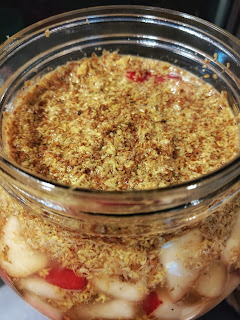Mead It Like A Viking!
I've been indulging my viking fantasies lately and just trying to ferment everything I can to make mead. Sans viking costume and helmet of course (will probably have to rethink that) ... While I enjoy beer and wine, I've just been curious enough to see what one can ferment at home.
So what exactly is mead you might ask? Mead is an alcoholic drink created by fermenting honey with water and most times flavored with various types of fruit, herbs and spices.
Of course the medieval ones never ones to be boring, had distinct names for the different types of mead. Don't believe me?
Melomel: Ones made with fruit (berries) and honey are called melomel.
Cyser: Ones made with apples and honey are called cyser (much like cider).
Pyment: And those that are made with grapes and honey is called a pyment.
Metheglin: Mead made with herbs and spices for intentional flavoring or medicinal qualities can properly be referred to as metheglin.
I still have yet to find the name of mead made with vegetables like mushrooms and squash! Too bad the name "veggemite" is taken!
Cornelian Cherry mead
The mead below is made with pears, goji berries and osmanthus flowers. Trying to mimic the recipe for Chinese osmanthus wine - what is known in Gui Lin China as Gui Hua Jiu (guìhuāJiu, 桂花酒)
Having tried different fruits, flowers and spices and even different types of honey, it's been an amazing blast! I can see why the vikings would ferment this stuff by the barrel load!!! Of course the truth is - After foraging for the never ending bucket loads of cornelian cherries from my front yard, one realizes there really is only so much jam and pickled cherries you can make. So the answer??? MEAD. I made five gallons of the stuff and gave them all away with none left for myself. And hey, it *IS* considered medicinal! What with the probiotic content present as well as current research showing that the lactic acid bacteria found naturally in honey can fight off some of the roughest drug-resistant infections.
Although there were some surprises one had to overcome like an extremely vigorous fermentation explosion all over my dining room. Note to self: cover the floor with newsprint paper! The vikings might have the right idea of a separate fermentation room....
Can you imagine telling the architect or realtor today .... "Yes the house /design is beautiful, BUT does it have a fermentation room? No? Then it's not complete."
Ha.
Mead can be made using commercial yeast or with a natural fermented bug. In the recipe below you can use either. And I've included a recipe for a ginger bug to use as well.
Enjoy! And let me know how it turns out for you!
Here's a little snippet of the orange mead fermenting away.... can you hear it????
Orange , Cornelius Cherry and Hawthorn Mead
Ingredients for 1 gallon (4 liters) mead
2–3 pounds (1–1.5 kg) light, floral honey
1 gallon (4 L) water
3 organic oranges
1 cups of cornelian cherries
1 cup hawthorn berries
2tbsp raisins
4 tablespoons (30 mL) bug / 2 packets of wine yeast
Spices
2 cinnamon sticks
2–3 cloves
3 crushed allspice seeds
Ginger (2–3 ounces [57 to 85 g] fresh grated or 3–4 thin slices
Process
1. Place water into a pot and heat to around 70° F (21° C).
2. Mix the honey with the water until it is well dissolved and pour the mixture back into a water jug/wide mouth glass gallon jar to about 2 inches (5 cm) below the neck.
3. Slice the oranges into thin rounds.
4. Add yeast/bug, fruit and all the spices, put the lid on tightly, and shake the jug/jar vigorously
5. Cover with paper coffee filter, or plastic wrap held on loosely with a rubber band. It will start fermenting and bubbling in 24hrs or so.
6. Let sit to ferment for about a week. Punch down through the fruit and stir every two days.
7. Place an airlock and cork in the opening, or cover with clean plastic wrap held on loosely with a rubber band.
8. Store in about 70degree Fahrenheit (21C) dark room.
9. After three weeks, rack/strain all the fruit and spices and place back in jug , jar or carboy.
10. After about two weeks, start tasting it. When you like it, bottle it and enjoy! If you want it stronger, you can let it ferment for another two weeks.
Recipe for Ginger bug below. You can use the ginger bug to make ginger beer, or even other types of soda. Recipes to come in the next blog post!
Ginger bug
2 cups (500 mL) distilled water
2 tablespoons (30 mL) organic cane sugar
2 tablespoons (30 mL) grated, diced, or chopped organic ginger with skin on
Process
1. Mix everything well in a quart jar or other wide-mouth container, cover with a cheesecloth, and let sit in a warm, dark corner away from other open ferments.
2. Continue feeding with equal amounts of ginger and sugar daily and stir several times a day until you have a bubbling bug, which can take anywhere from two days to a week.
3. Use a cup of the bug as a starter for a 5-gallon [20-L] batch, or a couple of tablespoons for a 1-gallon [4-L] batch.
4. Keep the bug going for future use by adding more sugar, and ginger





Comments
Post a Comment